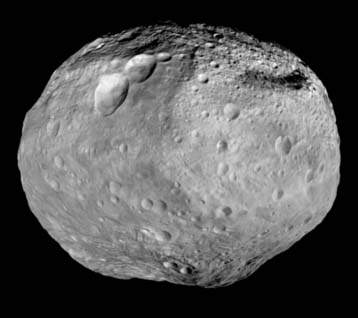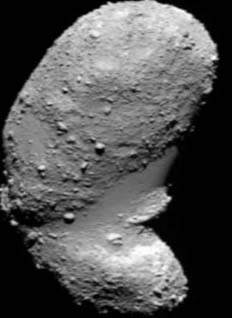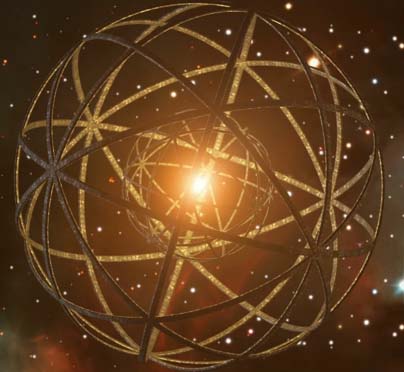Tapping More of the Sun's Energy to Deflect Asteroids
Allan R. Hoffman, U.S. Department of Energy (retired)
Introduction
Solar energy, after many years in the shadow of fossil fuels and nuclear fission, is capturing increasing public attention. The world has awakened to the dangers of global warming and climate change, the societal difficulties associated with widespread use of nuclear energy, and the growing promise of solar and other renewable energy resources[1]. This article discusses some of the numbers behind solar energy's increasing popularity and speculates about how we might derive even more energy from our mid-sized star in the event of a potentially fatal global threat from an incoming astero (see Fjgure 1).


Figure 1: asteroid shapes
Asteroid strikes on Earth and what can be done to prevent them is a topic of increasing concern and study. We now have the means to detect asteroids that are far away and calculate their orbits. The NASA-supported Sentry project[2] at the Jet Propulsion Laboratory/CalTech “…is is a highly automated collision monitoring system that continually scans the most current asteroid catalog for possibilities of future impact with Earth over the next 100 years.” Wikipedia defines asteroids as “..minor planets, especially of the inner Solar System…Millions of asteroids exist, many the shattered remnants of planetesimals, bodies within the young Sun's solar nebula that never grew large enough to become planets.”[3]
Basics
The basic physics is straightforward: the Sun is a nuclear fusion machine that fuses massive amounts of hydrogen into helium in a fusion process that releases massive amounts of energy. For his contributions in explaining energy and element production in stars, such as the Sun, Hans Bethe was awarded the Nobel Prize in physics in 1967.[4] for his contributions in explaining energy and element production in stars.
The sun radiates its energy uniformly in all directions, effectively as a 5500 degree Centigrade blackbody (perfect emitter). At this rate, the Sun’s hydrogen supply (estimated to be 2 trillion trillion million kilograms) will be exhausted in about five billion years. The Earth, at an average distance from the Sun of 93 million miles, intercepts only 4 parts in 10 billion of the energy radiated.[5] This exceedingly small fraction still provides 6 million quads of energy to the Earth’s disc annually, about 10,000 times more than our current annual global energy consumption (600 quads).
The problem with solar energy’s use on Earth is not its magnitude but its energy density. It is not a concentrated energy source as are fossil fuels and nuclear power, and gathering it to use it effectively can be expensive. However, great progress is being made in reducing the cost of solar energy, and today it is the fastest growing energy source on the planet.[6]
The Asteroid Problem
So why am I concerned about deriving more energy from the Sun? My answer is that we will need that extra energy to protect the Earth from damaging, and even existential, asteroid collisions.
The solar system contains many non-planetary chunks of matter, both large and small (asteroids, meteors, comets), that can do serious damage if they collide with the Earth. For example, it is widely believed that a large asteroid crashed into the Earth 66 million years ago and led to the extinction of the dinosaurs and many other species. These chunks of matter are in orbits around the Sun, and, over time, the orbits of some of these chunks may bring them into collision with the Earth. In fact, the Earth is constantly bombarded by chunks of space matter, most of which burn up in the atmosphere. Given cosmic time scales, a damaging collision of the Earth with a large asteroid is inevitable.The issue then becomes: How do we change its orbit to miss the Earth? This takes lots of energy (how much is discussed below), and the only source of ‘lots of energy' that we have is the Sun.
How Much Energy?
My initial ‘back-of-the-envelope’ approach to this problem, to get a feel for the numbers, is to assume a spherical asteroid with a diameter D of 120 meters (about the size of a baseball field) moving in its orbit at a speed v of 20,000 miles per hour (18,940 meters per second). I further assume that I need to change the asteroid’s orbital kinetic energy (KE = 1/2 mv2) by 10% to divert it from its collision course with the Earth. (Note: 10% is likely a conservative assumption) To calculate this kinetic energy I assume an asteroid density of 3 grams per cubic centimeter (3,000 kg per cubic meter).[7] At D = 120 m, the asteroid's volume V (0.5324 D3) is 905,000 m3. This gives the asteroid a mass of 2.7x109 kg and a kinetic energy of 4.9x1017 joules (0.46 quads; 1 quad = 1.055x1018 joules). 10% of this is 0.05 quads. If the asteroid's diameter doubles ( to the equivalent of an 80 story building),[8] this number increases to 0.4 quads. If the asteroid’s speed also doubles to 40,000 mph, this number goes to 1.6 quads.
Obviously, readers can plug in any numbers they want. NASA Science's ‘Solar System Exploration' website[9] says the following about asteroid size: “Asteroids range in size from Vesta—the largest at about 329 miles (530 km) in diameter - to bodies that are less than 33 feet (10 m) across.” With respect to asteroid orbital speeds, the Lunar and Planetary Institute website[10] states that: “Asteroids, the most common type of impactor, slam into the Earth at an average velocity of 18 km/s.” (40,300 mph).
Plugging in 50 km for D and using the above average impact velocity for v, 10% of the asteroid's KE is 15 million quads, well beyond anything based on Earth-bound systems. Are such numbers possible by tapping into more of the Sun's radiated energy?
The Dyson Approach
Using numbers provided earlier, we can calculate that the Sun's total radiative output is 1.5x1016 quads, considerably greater than the 15 million quad number above. So the question becomes: How can we capture more of the Sun's energy in case we need it to avoid a catastrophic asteroid collision? Freeman Dyson had one answer when he proposed, in 1960, “..a hypothetical megastructure that completely encompasses a star and captures a large percentage of its power output…The concept is a thought experiment that attempts to explain how a spacefaring civilization would meet its energy requirements once those requirements exceed what can be generated from the home planet's resources alone.”[11]
This megastructure is now known as a Dyson Sphere and is the subject of numerous science fiction stories, and engineering and design studies (see Figure 2).

Figure 2: sci-fi sketch of what a Dyson Sphere could be[12]
It should be noted that Dyson considered a solid spherical shell of matter surrounding a star to be “..the least plausible variant of the idea.” In response to letters commenting on his concept, Dyson replied that “A solid shell or ring surrounding a star is mechanically impossible. The form of ‘biosphere' which I envisage consists of a loose collection or swarm of objects traveling on independent orbits around the star.”[13]
The PV Approach
So what would a plausible swarm look like? The literature describes several possibilities, most of them swarms of photovoltaic (PV) cells that convert sunlight directly into electricity. Thus, how much electrical energy can be generated by placing arrays of solar cells in orbits around the Sun that are closer to the Sun than 93 million miles? This is of interest because the intensity of solar radiation increases inversely to the square of the distance to the Sun. The goal would be to get as close to the Sun as practical to increase the energy capture and resultant electrical generation. This requires PV devices that do not overheat when in such close proximity to the Sun, and one or more means of transmitting/storing the electrical energy generated for later use in deflecting the asteroid - all interesting engineering problems.
The Solar Constant, the energy received by the Earth from the Sun, averaged over its elliptical orbit around the Sun, is 1,360 watts per square meter (w/m2).[14] This ‘Constant' becomes 5,440w/m2 at half the distance to the Sun and 21,800 w/m2 at one quarter of the distance to the Sun.
Can a PV array positioned closer to the sun be cooled enough to not burn up and kept at a reasonable operating temperature? This latter issue is also a problem for Earth-based PV systems, as semiconductor devices deteriorate in solar-to-electricity conversion efficiency as they heat up. While recognizing that this can be a difficult problem to solve, I would note that NASA's Parker Solar Probe, currently in an elliptical orbit around the Sun, will be within 4 million miles of the Sun's surface at its point of closest approach while gathering data continuously.
The heat shield that protects the Parker spacecraft “..is made of two panels of superheated carbon-carbon composite sandwiching a lightweight 4.5 inch thick carbon foam core.” It weighs only 160 pounds, and at the probe’s closest approach to the Sun “..temperatures on the heat shield will reach nearly 2,500 degrees Fahrenheit, but the spacecraft and its instruments will be kept at a relatively comfortable temperature of about 85 degrees Fahrenheit.”[15] Excess heat is discarded via a heat sink to space where temperatures are just above absolute zero.
Possible Orbits
While there are many possible orbits for satellites around the Sun, I choose only one for purposes of calculation - an object orbiting the Sun at a distance of 30 million miles. The equations of orbital mechanics[16] dictate that this satellite will be moving at 52.6 km/s(117,666 mph). The time to complete one orbit will be 5.77 million seconds (2.2 months), and the orbit's length will be 304 billion meters (189 million miles).
If we assume an orbital spacing between PV arrays of 500 (1000) miles we could place 377,000 (188,500) shielded PV arrays along this orbit. Assuming, conservatively, that each array is capable of generating 80 watts per square foot, based on today’s high concentration solar cells (861 watts per square meter), and that each solar array is 100 square meters in area, in principle we could collect 754,000 kWh (2.57x10-6 quads) per year per array. The energy harvest of the total swarm of arrays would then be 284 (142) billion kWh, or 0.969 (0.485) quads. If the array areas are increased to 1,000 square meters and the conversion efficiency is increased to 100 watts per square foot, the yearly collected electrical energy totals rise to 12.1 (6.05) quads.
Conclusions
These numbers give one a feel, energy-wise, for what is possible, with flexibility to change lots of parameters: orbital distance from the Sun, size and efficiency of the PV arrays, number of arrays in one orbit, and even the number of orbits used. The clear conclusion is that, in principle, quads of energy can be harvested by solar arrays in orbits around the Sun if the many associated engineering problems can be addressed. From a pure physics/orbital mechanics perspective, such orbital systems are feasible. An obvious concern is what kind of solar collector can survive such an orbital environment, not only thermally but also in terms of exposure to high-energy radiation from the Sun. I leave it to others to comment on this problem, but with one thought: diamond is a high temperature, high thermal conductivity material that can be doped to act like a semiconductor and serve as a solar cell. Perhaps that is one avenue to pursue.
Other issues are getting the generated electricity from the orbital arrays to the moon or some other intermediate storage location, and then transmitting large quantities of energy to the asteroid to slowly but steadily change its orbital kinetic energy and therefore its orbit. The obvious first guess is the use of directed lasers powered by the generated/stored electricity. I leave it to others more qualified in laser and energy storage technology to discuss this further.
Two final thoughts: the energy levels involved in a collision with a large asteroid may be beyond anything that we can address[16]. Also, analysis of these issues would make an interesting set of PhD problems.
References
[1] International Energy Agency, ‘Renewables 2019: Market analysis and forecast from 2019 to 2024’, http://iea.org/reports/renewables-2019
[2] Jet Propulsion Laboratory, California Institute of Technology, ‘Sentry: Earth Impact Monitoring', http://cneos.jpl.nasa.gov/sentry
[3] Wikipedia, ‘Asteroids', http://en.m.wikipedia.org/wiki/Asteroid
[4] Wikipedia, ‘Hans Bethe', http://en.m.wikipedia.org/wiki/Hans_Bethe
[5] geometric calculation: (area of Earth's disk)÷(area of sphere 93 million miles in radius)
[6] International Energy Agency, ‘Renewables 2019: Market analysis and forecast from 2019 to 2024', http://iea.org/reports/renewables-2019
[7] PennState Center for Astrostatistics, ‘Asteroid densities’, http://astrostatistics.psu.edu/datasets/asteroid_dens.html
[8] abc NEWS, ‘Asteroid size of Empire State Building to pass Earth Saturday Night', http://abcnews.go.com/US/asteroid-size-empire-state-building-pass-earth-saturday/st
[9] NASA Science Solar Systems Exploration, ‘Asteroids', http://solarsystem.nasa.gov/asteroids-comets-and-meteors/asteroids/overview/?pag
[10] Lunar And Planetary Institute, ‘Asteroids and Comets: Average Terrestrial and Lunar Impact Velocities', http://lpi.usra.edu/exploration/training/illustrations/craterMechanics
[11] Freeman J Dyson (1960). “Search for Artificial Stellar Sources of Infra-Red Radiation”, Science 131, http://en.m.wikipedia.org/wiki/Dyson_sphere
[12] Victoria Dmitruczyk, ‘Harnessing the Sun’s Energy - Building the Dyson Sphere”, http://medium.com/@12vgt2003/harnessing-the-suns-energy-building-the-dyson-sphere
[13] Freeman J Dyson response (1960), http://islandone.org/LEOBiblio/SETI1.HTM
[14] Wikipedia, “Solar constant”, http://en.m.wikipedia.org/wiki/Solar_constant
[15] NASA, “Cutting-Edge Heat Shield Installed on NASA’s Parker Solar Probe”, http://nasa.gov/feature/goddard/2018/cutting-edge-heat-shield-installed-on-nasa-s-parker-solar-probe
[16] Sean Victor Hum, “Brief Introduction to Orbital Mechanics”, http://www.waves.utoronto.ca+notes
[17] Mike Wall, “A Killer Asteroid Is Coming – We Don't Know When (So Let's Be Ready), Bill Nye Says”, http://space.com/killer-asteroids-warning-bill-nye.html
These contributions have not been peer-refereed. They represent solely the view(s) of the author(s) and not necessarily the view of APS.
